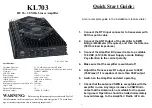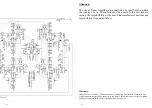
3
Front / Rear Panel Description
Front Panel
1.
Receive Pre-Amplifier ON / OFF Switch
2.
Amplifier ON / OFF Switch
3.
Input Attenuator (LOW / MID / HI), (For output power adjustment).
4.
AM / SSB Switch
5.
Pre Amplifier ON LED
6.
Amplifier ON LED
7.
TX indicator LED
Rear Panel
1.
RTX SO239 RF input connector
2.
DC Input power connector. (Polarity is marked on the supplied mating
connector)
3.
ANT RF Output SO239 Socket to Antenna
4
Installation:
Unpack the amplifier from it’s shipping carton and inspect for any signs of damage. The ampli-
fier should be installed (either fixed or mobile installation), in a place that allows good ventila-
tion and provides a suitable base to support it. Failure to allow for reasonable ventilation will
cause the amplifier to overheat and damage may occur. A short 50 Ohm patch lead should be
used to connect the amplifiers RTX SO239 input
[
connector to the output, (Antenna Socket)
of the drive Radio. This length of this cable is not critical but should be of good quality and be
kept as short as practically possible. The ANT output
]
connector of the amplifier should then
be connected to antenna being used. (If an external SWR/Power meter is to be used the ampli-
fier should be connected to the input and then the antenna to the output, This order of connec-
tion is very important. Check also that the Antenna is suitably rated for the power output level.
(Antenna SWR should not change much from low to high power). The antenna should be tuned
before connecting the power amplifier or with the amplifier switched OFF! .
In SSB mode the front panel switch
^
should be set to SSB. This adds a short delay to the
release time of the RTX relays so that pauses in speech do not cause the RTX relay to drop out.
In AM or FM mode the SSB delay switch should be set to AM.
The amplifier must be connected via the input power connector
\
to a suitable power supply of
the correct voltage output and sufficient current rating. The output should be 13.6 / 13.8V DC
but the amplifier may be connected to a supply from 12V to 14V DC without damage. The cur-
rent rating of the power supply must be at least 60A continuous. Be aware that the current rat-
ing must be greater still if the drive radio is also connected to the same power supply, although
this is not generally advised.
The voltage output and current rating are very important for low voltage (12V) RF transistors as
voltage sag, (poor load regulation) or insufficient current capability can drastically reduce the
output power or cause distortion. If full output is not seen then the first thing to check is that the
voltage remains above 12.5V at full load. Anything less indicates the power supply is not suit-
able for the amplifier at full output.
The cross sectional area of the cables used to connect the amplifier to the PSU should not be
less than 10mm
²
or 7 AWG
.
They should also be kept as short as practicably possible to avoid
voltage drop due to ohmic losses. This is less of a problem in a fixed installation where the
power supply may be placed close to the amplifier.
For a mobile installation the leads should not exceed a length of 3m and they should be con-
nected directly to the auto battery. An additional fuse may also be connected inline to provide
protection in case of cable short circuit to chassis ground from the amplifier to the battery.
























